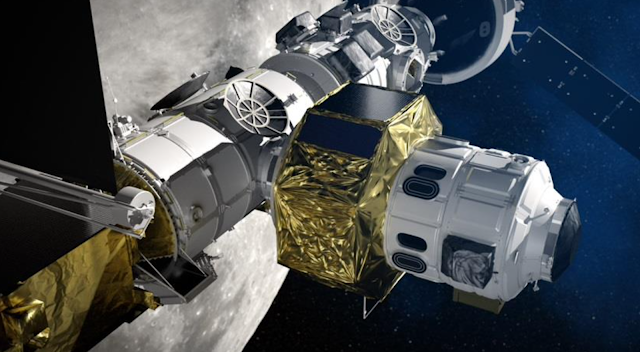Gateway patch.
Sept. 30, 2022
In brief
ESPRIT is the name for ESA’s elements for the Lunar Gateway, and part of Europe’s contribution to the creation of the international outpost orbiting the Moon. The name is an abbreviation of European System Providing Refueling Infrastructure and Telecommunication, that shows the variety of functions that ESPRIT provides to the lunar Gateway.
Gateway zoom on ESPRIT
In-depth
The Gateway will be a habitat, refueling and research centre for astronauts exploring our Moon as part of the Artemis programme.
The refueling and infrastructure and the telecommunication functions are provided by two different elements that will reach Gateway at different times. The two elements are:
- The HALO-Lunar Communication System - a communication system installed on NASA’s Habitation and Logistic module (HALO). The HALO-Lunar Communication System will allow the Gateway to communicate with astronauts and rovers on the Moon’s surface, in orbit and when close to the Gateway.
- The European Refueling Module - a habitable space for astronauts with cargo space and fuel tanks to store propellant for the Gateway.
Gateway over Moon
HALO-Lunar Communication System
The HALO-Lunar Communication System (HLCS) is a self-standing tele-communications element with its own computers, radio equipment and antennas. It provides radio links with satellites, rovers and human landers heading to and from the Moon’s surface, as well as spacecraft around the Gateway. Two antennas will be able to follow and maintain communications with multiple targets simultaneously.
What is ESPRIT?
The system will allow for high data speeds that can support live video transmission even when the Gateway will be at the farthest distance from the Moon – 70 000 km from the surface. HLCS will allow for voice and high-definition video links and can calculate information on distance and relative speeds between the Gateway and elements connected to its radio link.
Antennas:
The HALO-Lunar Communication System has two 125-cm dish antennas, each operating simultaneously and independently to keep communication with radio targets.
ESPRIT HALO-Lunar Communication System
Radio frequency bands:
Provides a combination of two simultaneous communication links in S/S, S/K, and K/K radio frequency bands.
Communication speed:
From few Kbps up to 25 Mbps depending on distance.
Ranging capability:
Over S-band.
Overall size:
2.5 m x 2.5 meter.
Weight:
270 kg.
Power consumption:
Up to 600 W of power.
The design is complete and manufacturing has started using European companies.
ESPRIT Refueling module
The ESPRIT refueling module is part of the Gateway’s core structure. The module is 4.6 m in diameter and 6.4 meter in length. It weighs around 10 tonnes on Earth filled with fuel.
The ESPRIT Refueling Module (ERM) has four main functions: transport cargo to the station, provide storage space once docked at Gateway, provide fuel to propulsion system of Gateway (NASA’s Gateway Power and Propulsion Element), and provide a view of space and the Moon through its windows.
Gateway with ESPRIT module right
The ERM has two main structural elements: the pressurised tunnel where astronauts can float inside (the white cylinder pictured above) and an unpressurised element surrounding part of the pressurised hull.
The pressurised tunnel is a habitable environment used for storage and offering passage between the two docking ports at each end of the tunnel. At launch the ESPRIT module is designed to hold cargo of up to 1.5 tonnes.
ESPRIT refueling module
The pressurised tunnel has six windows and one workstation position, where astronauts can dock their laptops, cameras and other tools to work especially when an outside view is required, such as docking spacecraft or operating robotic arms.
The unpressurised system is a set of external volumes in which the module’s computer and refueling systems are hosted. The unpressurized system is clearly visible as octagonal gold ring around the white tunnel. Batteries are also mounted outside on the surface of the pressurised tunnel, providing power to keep ESPRIT operating at the right temperature on its voyage to the Gateway orbit.
Angelic halo orbit chosen for humankind’s first lunar outpost
The Gateway propulsion system utilises two types of propellants: the standard chemical propellant used by most modern spacecraft, and xenon. Xenon is a noble gas used in electric propulsion systems to generate thrust by first electrically charge and then accelerate with electric fields the gas molecules. Electric propulsion systems are very “fuel” efficient, requiring less than ten percent of the propellant required by chemical propulsion system for equivalent transfers. Capability to refuel these types of propulsion systems is one of the likely keys to enable human interplanetary mission. In addition to the propellant ERM will bring to the station, the module also allows a tanker spacecraft to dock with its free port to provide further refills.
Team Gateway Europe
The prime contractor and system designer of both ESPRIT elements is Thales Alenia Space in Cannes, France. They are managing a large Industrial consortium supplying the components and services that will make ESPRIT. For the ESPRIT Refueling Module ERM, the design and responsibility is shared with a group of companies that, together with Thales Alenia Space, form the core team:
- OHB in Bremen, Germany, is designing the unpressurised element and the Xenon refueling system / https://www.ohb.de/en/
- Thales Alenia Space in Turin, Italy, is designing and manufacturing the pressurised tunnel / https://www.thalesgroup.com/en/countries/europe/italy/space-italy
- Thales Alenia Space in the UK is designing and manufacturing the chemical propellant system / https://www.thalesgroup.com/en/worldwide/space/news/thales-alenia-space-uk
Testing Comex design for ESPRIT airlock
Related links:
Thales Alenia Space in Cannes, France: https://www.esa.int/Science_Exploration/Human_and_Robotic_Exploration/European_Gateway_module_to_be_built_in_France_as_Thomas_Pesquet_readies_for_second_spaceflight
Gateway: http://esa.int/gateway
Images, Video, Text, Credits: ESA/Thales Alenia Space.
Greetings, Orbiter.ch









